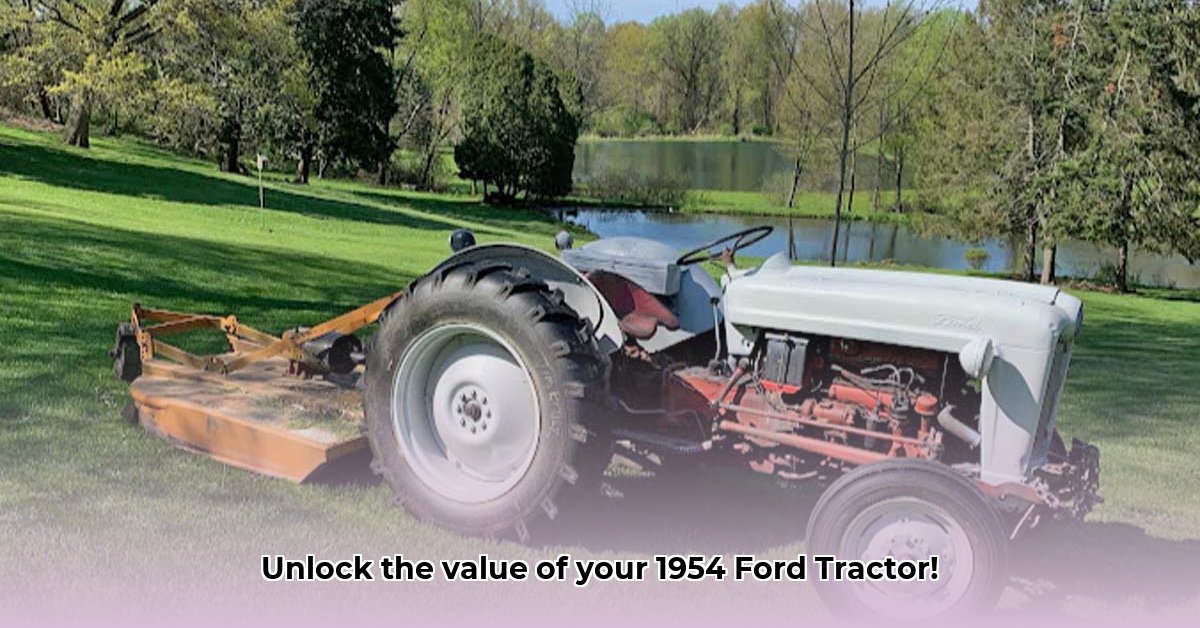
The 1954 Ford tractor—a timeless symbol of American ingenuity and agricultural heritage—holds a special place in the hearts of collectors and enthusiasts. More than just a machine, it represents a bygone era of robust craftsmanship and dependable performance. But navigating the market for these classic tractors requires careful consideration. This guide provides a comprehensive market analysis and actionable advice for both buyers and sellers. For more in-depth information, check out this detailed resource.
Market Overview: Understanding the Price Spectrum
The market for 1954 Ford tractors is dynamic, with prices ranging significantly. While some tractors sell for as low as $2,000, others command prices exceeding $8,000. This substantial variation stems primarily from several key factors:
Condition: A meticulously restored tractor, pristine and gleaming, naturally commands top dollar. Rust, wear, and tear significantly impact value, much like with classic cars. A well-maintained tractor reflects its age gracefully, commanding a higher price.
Hours of Operation: Similar to a car's mileage, lower operating hours indicate less wear and tear, making the tractor more desirable and valuable. A tractor with few hours is essentially a time capsule of agricultural history.
Auction Dynamics: The excitement and competitive bidding at auctions often drive prices higher than private sales. Buyers should be prepared for intense competition and potentially higher costs within the auction environment. Private sales offer more control over negotiation.
Market Fluctuations: External factors, such as fuel prices, economic trends, and even interest rates, influence market values. Shifts in the classic vehicle market also play a significant role.
Visualizing price ranges with charts and graphs would provide a clearer picture of the market dynamics.
Buyer's Guide: Making a Smart Purchase
Purchasing a 1954 Ford tractor requires careful planning and due diligence. Following these steps will significantly increase your chances of a successful transaction:
Pre-Purchase Inspection: A qualified mechanic specializing in classic tractors should thoroughly inspect the machine. This expert assessment identifies potential problems, saving you from costly repairs.
Price Comparison: Research online marketplaces, auction sites, and classified ads to compare prices of similar tractors. Consider the seller's location (shipping costs) and document the features and their condition.
Negotiate Wisely: Don't hesitate to negotiate the price based on your research. A polite and respectful approach can yield beneficial results.
Identify Reliable Sources: Build relationships with reputable sellers and dealers. Collector communities can offer valuable recommendations. Dealing with established sellers minimizes the risk of purchasing a problematic tractor.
Thorough Documentation: Secure proper paperwork verifying ownership and maintenance records. These documents are crucial for insurance and registration.
Seller's Guide: Maximizing Your Return on Investment
Successfully selling your 1954 Ford tractor requires a strategic approach focused on maximizing value and attracting the right buyer:
Honest Assessment: Be realistic about your tractor's condition. Accurate descriptions build buyer trust and confidence. Highlight positive aspects while being upfront about any flaws.
Market Research: Thorough research is critical for setting a competitive and realistic price that reflects the tractor's current market value. Use various online resources to identify comparable sales recently.
Presentation Matters: High-quality photos showcasing the tractor's best features and a detailed, engaging description are essential. Consider a video demonstration highlighting functionality.
Comprehensive History: Provide a detailed history of the tractor, including maintenance logs and repair records. This adds value and assures potential buyers of its authenticity.
Strategic Promotion: Utilize effective advertising channels, such as online marketplaces, local tractor shows, and enthusiast forums, for broader reach and targeted marketing.
Market Trends and Future Outlook
While predicting the future is always challenging, several factors will likely influence the 1954 Ford tractor market:
Consistent Demand: Enthusiasm for classic tractors remains relatively stable, suggesting that your investment may hold value over time. The appeal of owning a piece of agricultural history endures.
Economic Influence: Fuel prices, economic downturns, and changing interest rates can affect demand and thus pricing. Stronger economies typically lead to increased collector spending.
Part Availability: The scarcity of original parts and the overall availability of well-maintained tractors will influence future price trends.
Conclusion: Due Diligence is Key
Buying or selling a 1954 Ford tractor is a significant undertaking. Thorough research, careful planning, and a cautious approach are vital for a successful transaction. Remember that patience and a realistic assessment of the market are invaluable assets in this exciting niche of classic machinery. Investing time in research and due diligence will undoubtedly yield the best results and contribute to a fulfilling ownership experience.